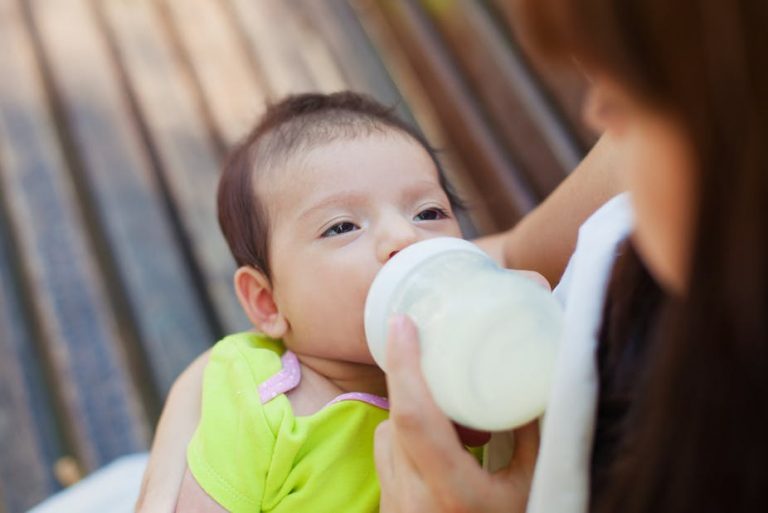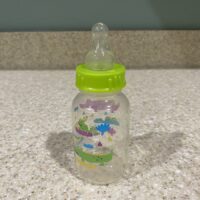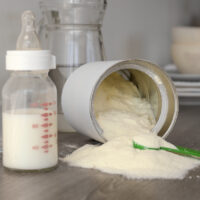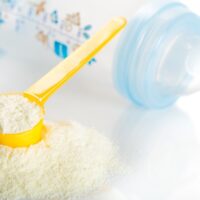Editor’s Note
As of May 2022, many formulas have become increasingly difficult to find. Please read our article, What To Do If You Can’t Find Baby Formula, for more information regarding the formula shortage if you are looking for formula feeding tips.
The American Academy of Pediatrics recommends solely breastfeeding until age six months old. When breastfeeding is not possible, formula is the appropriate source of nutrition for infants. “First foods” may be introduced as early as four to six months old. But, did you know this does NOT mean it is time to stop formula feeding your baby?
Whether you are breast or formula feeding, this is the primary source of nutrition for your little one during the first year of life. Infants require a constant supply of nutrients and calories to support their rapidly developing bodies and brains.
Keep reading to learn when to discontinue infant formula, and how much your baby should eat at each stage of their development.
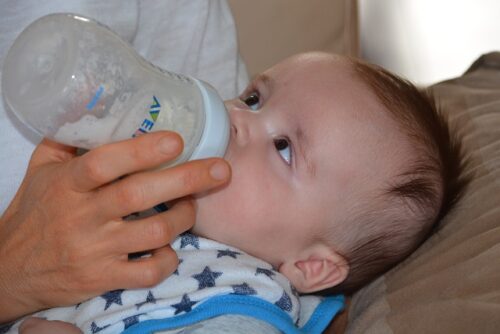
How Much Formula Does My Baby Need?
The amount of formula an infant takes varies with age. Newborns usually take one and a half to three ounces per feeding based on birth weight and feeding ability (source). The volume of formula an infant can tolerate per feeding increases every few months, and most six month olds are hungry enough for six to eight ounce bottles. However, every baby is different. Do not force your baby to take a specific amount of formula, and keep in mind that your little one’s appetite will fluctuate. This infant formula feeding guide may be helpful, but your little one may not drink the same amount each day. With growth spurts, the dietary needs will change.
Until your baby’s first birthday, he or she should receive infant formula instead of cow’s milk. You should not stop formula prior to this age.
Some parents choose to introduce food or juice between four and six months of age. Because of the high sugar content and limited fiber, juice is discouraged by most health authorities (source). Beginning foods at four months old is ok as long as your little one is showing signs of readiness. This means having good head support, and the ability to remain upright in a highchair. During infancy however, foods are considered supplements to your little one diet. They do not replace the nutrition obtained from formula.
One way to be sure babies are getting a wide variety of foods is by making your own baby food. It’s easy with one of these baby food makers.
Choosing the Right Formula
The sensitive tummies of babies are not always appeased by a one-size-fits-all infant formula. Some babies struggle with gas problems, while others have GERD or colic. While these symptoms may improve by using an anti-gas bottle, other babies have symptoms because their digestive systems do not process the formula well. In these cases, switching to a gentler formula might help. There are many factors to consider, but the most important thing to remember is that formula provides the nutrition your baby needs. If you need help in making a decision, speak to your pediatrician. Also, be sure to check out our best formula reviews.
How to Choose Baby Formula
Baby formulas are modeled after breast milk, with both having similar nutritional values. The major differences are the types of ingredients, and how they are processed. Here are some things to consider:
- Preparation- Formula is available as a ready-to-feed liquid or in a powdered form that requires mixing. Ready-to-feed versions are more expensive, while powdered ones are more affordable. Because each brand is different, you’ll need to read and follow the specific formula preparation instructions (source).
- Additional Benefits- Some formulas are designed in a special way for babies who have digestive issues. For example, some babies need a soy-based formula instead of a dairy-based one because they cannot digest milk sugars. This type of disorder would be detected by the newborn screening test performed in the hospital after birth. Other babies might require a formula with proteins that are more processed. These include unique formulas for babies with colic, reflux, sensitive tummies, and cow’s milk allergy. If your little one is having any of these problems, it can be helpful to talk to a pediatrician about which option is best.
- Taste- Although formulas can taste similarly, there may be slight differences that cause your little one to prefer one brand over another. If this seems to be the case with your baby, ask your doctor for formula samples before investing in a big purchase. You may be able to contact manufacturers directly for samples or coupons as well.
Tips to Make Formula Feeding Easier
If your baby dislikes the taste of formula, this can create feeding struggles. Here are some helpful tips to encourage your infant to drink formula.
#1: Consider the Temperature
Infant formula does not need to be warmed. Babies may even prefer cooler formula during the hot summer months. If so, let your baby drink it that way. However, warm infant formula is also closer to the temperature of breast milk. If your baby prefers it warmed, be sure to do it safely (source). Although immersing the bottle in a warm pan of water may do the trick, these bottle warmers provide an additional way.
#2: Don’t Reuse Formula
Baby formula is expensive. Parents who exclusively formula feed typically spend $70-150 per month on it. Even though it can be frustrating when your little one takes only a sip of the four ounces you have just prepared, the formula should not be reused. If your baby hasn’t touched the nipple, the formula can be stored in a refrigerator for up to 24 hours (source). If he or she has taken a drink, you should throw out what remains in the bottle. Backwash or bacteria can contaminated the formula through the nipple.
#3: Use Safe Preparation Techniques
Formula feeding is safe, but only if you prepare your little one’s formula properly. Always wash your hands before making the formula. Additionally, properly wash and sterilize the bottles and equipment after feedings. Keeping up with bottle cleaning can be a challenge, but bottle sterilizers can make it significantly easier.
#4: Position the Bottle Well
It is not always the formula that makes your little one spit-up. Babies often spit up because they were not burped properly after a feeding, or because the angle of their bottle caused them to swallow a lot of air. In addition to bottle positioning, you should consider the type of bottle you are using. Some bottles are better than others, especially if your baby has colic or reflux.
#5: Avoid Formula-Feeding Shamers
When you are having difficulty feeding your little one, other moms or extended family members may insist that your problems are due to formula feeding. It does not matter why you have chosen to give formula. Feel confident in your decision. Know that the most important thing is that your baby is fed.
FAQs About Formula Feeding
Can I stop formula feeding prior to 12 months if my infant no longer likes it?
As a parent, there will be many times when your child will not enjoy what you are doing. For example, taking your little one to the doctor for regular check-ups is important for monitoring growth and development, despite their discomfort of receiving vaccines.
Formula feeding is as important as those check-ups. It is more than just a cow’s milk-based product meant for babies. It is specifically formulated to support an infant’s nutritional needs. Whole cow’s milk is inappropriate because it lacks sufficient vitamin E and essential fatty acids that promote weight gain and cognitive development (source). Infant kidneys are not mature enough to handle the high amount of sodium and potassium. Cow’s milk also lacks iron, and giving it to babies too soon can cause anemia (source). For these reasons, even if it becomes difficult, you should try to continue formula until the first birthday. If the amount your infant takes significantly decreases, be sure to offer a variety of supplemental foods that provide proteins, fats, iron, and vitamins.
Sometimes, switching formula brands may appeal better to your baby’s taste preferences. You can compare the differences between Enfamil and Similac formulas here.
Do I need to use bottled water in my baby’s formula?
If the tap water in your home is safe to drink, you can use it to prepare your baby’s formula.
If you use bottled water, speak to your pediatrician about fluoride supplementation at six months of age. Fluoride is a necessary mineral for encouraging dental health. It is found in tap water, but not in bottled or well water. Some commercial nursery water brands, however, do contain fluoride. As many babies start cutting teeth around six months old, it is important that they get fluoride to support this process.
When should I introduce milk to my baby?
You should not introduce milk to your baby until they are at least one year old.
Prior to this age, foods like yogurt and cheese may be introduced around six months of age unless your baby has a cow’s milk protein allergy. Yogurt and cheese are more processed than milk, so the proteins are broken down. Just check the labels to be sure these foods are pasteurized to prevent any food-borne infections. When choosing yogurt for your baby, be sure to select full-fat varieties.
How do I know if my baby is drinking enough formula?
Before babies begin to talk, they rely on you to understand their needs. While this can be frustrating, especially during a crying episode. most parents can eventually interpret their baby’s cues.
As your little one’s nutritional needs fluctuate, you will learn to recognize hunger and fullness cues.
Hungry babies have a way of letting you know. Gestures such as opening and closing the mouth, pointing to the mouth or at food, and appearing excited when formula is offered are all signs that your little one is ready to eat.
Babies will also let you know they are full by closing their mouths, and refusing to accept food. When full, you should stop the feeding. Babies are still learning their body’s hunger and satiety cues. Forcing them to eat when not hungry can cause future appetite problems and obesity (source).
Teaching your little one baby sign language can also help. This is a type of communication your baby can use before knowing how to say words. It prevents misunderstandings, and helps parents figure out exactly what their baby wants.
Final Take
Your baby’s body and brain demand high levels of nutrition and many calories during the first year of life. The bottom line is that, even after introducing foods, your little one will need to continue drinking formula or breast milk for at least the first year. After that, your toddler can be weaned off of infant formula, and given whole cow’s milk or soy milk (source). In the meantime, make sure your baby gets the most from bottle feedings.
If you still find yourself wondering when to stop formula, speak to your baby’s pediatrician. He or she will be able to provide specific advice about your baby’s caloric and nutritional needs.
